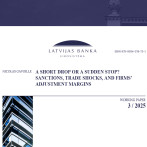Latvian economy growing but second wave of crisis approaching
According to the flash estimate by the Central Statistical Bureau (CSB), the annual growth of gross domestic product (GDP) in constant prices reached 5.7% in the third quarter of 2011. Quarter-on-quarter the growth has been 1.3% (seasonally adjusted data).
Such GDP growth can be considered as a success, particularly against the external economic background. Several operational indicators pointed to GDP growth in this quarter already earlier. The industrial production output volumes in the third quarter of 2011 grew 2.0% in constant prices (seasonally adjusted quarter-on-quarter data), which, albeit a slower increase than before should be considered good performance by Latvian manufacturers in the circumstances of weakening external demand. The most substantial contribution to GDP growth in the third quarter is likely to be the 5.7% increase in retail turnover (seasonally adjusted quarter-on-quarter data). The retail turnover continued growing in all months of the third quarter despite a gradual deterioration in the retail confidence. The economic sentiment index evaluated by the European Commission in the third quarter grew by 0.5 percentage points in Latvia while deteriorating substantially in the majority of European countries: in the EU at large it dropped a total of 10.7 percentage points. The operational tax revenue data also pointed to growth in the third quarter.
Latvian GDP recovered successfully after the crisis and we rapidly joined the EU leaders in terms of growth. Yet it does not imply a guarantee that such a trend will continue to hold in the coming quarters. The economies of the debt crisis ridden EU countries are gradually beginning to slow down: this is corroborated by confidence indicators, the Purchasing Managers Index, and the real economy data alike. The financial markets have been fluctuating in recent months. In all likelihood therefore, the escalation of fiscal consolidation measures and the risks related to debt-correction measures will soon enough transfer from the financial markets to the real economy and in some countries, including our foreign trade partners, the impact will be very negative. An increase in the evaluation of EU manufacturer store volumes is already the case, which indicates a drop in demand gradually pressuring manufacturers to reduce output. In some countries, e.g., Germany, Estonia, Spain, Portugal, Lithuania and elsewhere output has already dropped but it is too early to tell whether it can be considered a trend. After the downslide, the Latvian economy has been growing fast and is much better prepared for the second wave of the crisis than before yet it does not mean that we can entirely avoid getting wet, so to speak. The term "budget deficit" means that we are living by means of borrowed money. Therefore, if we understand that tomorrow our income will not increase and may even drop, the budget should be planned out very carefully. If that is not the case, we will increase our dependence on the developments in the financial markets, which at the moment are hardly beneficial.
Finally, we should keep in mind that the published GDP data are only a "flash estimate", which is obtained by the CSP by processing the already available information by means of mathematical models. A more precise and extensive GDP evaluation will be published on 9 December 2011 and then we will have a better idea about the moving forces of the economy.
Textual error
«… …»






